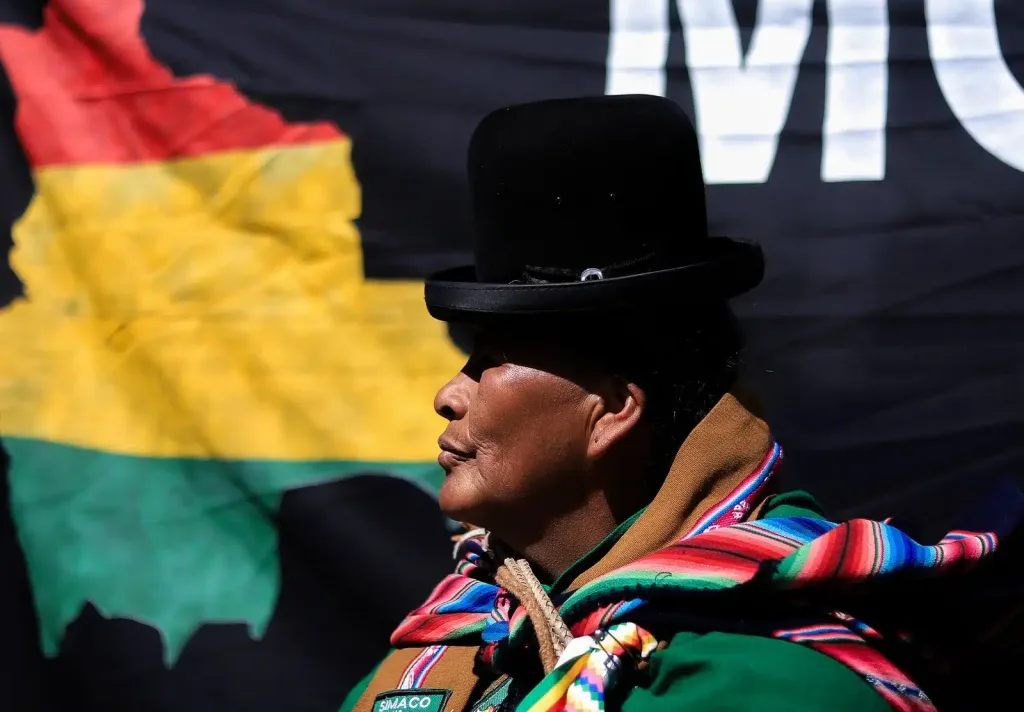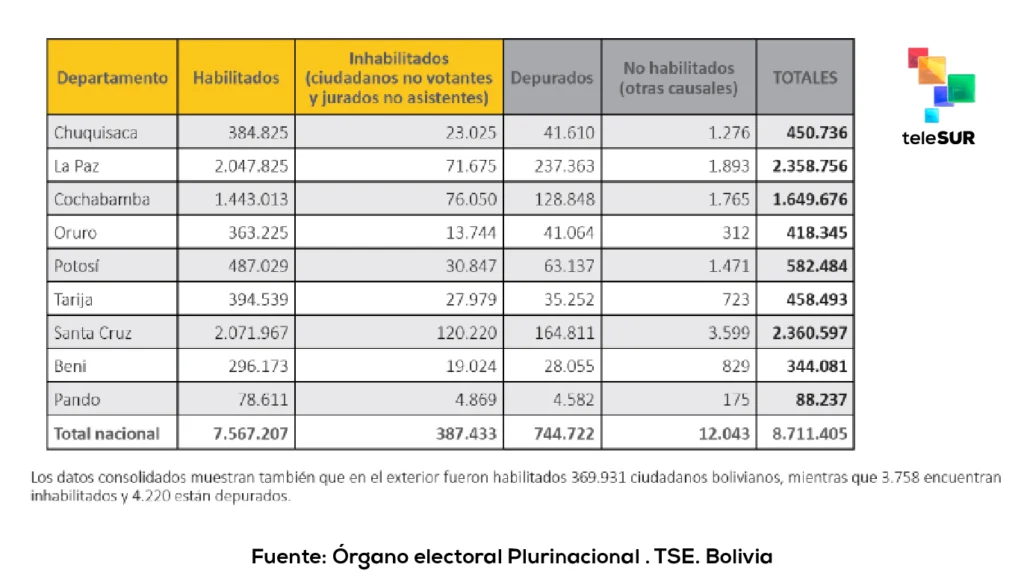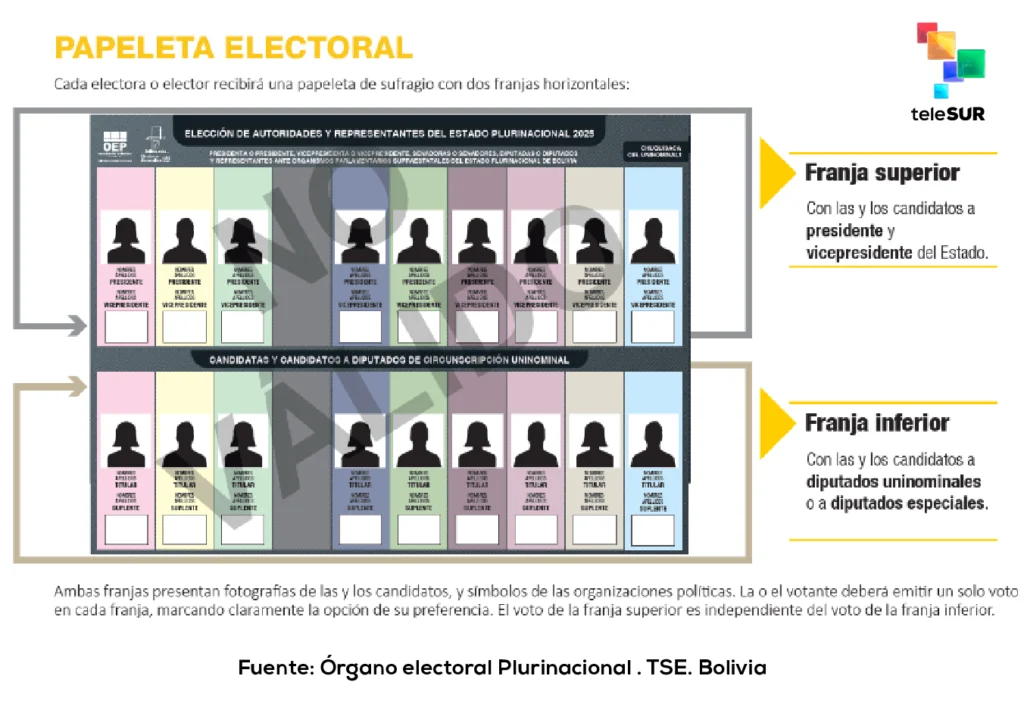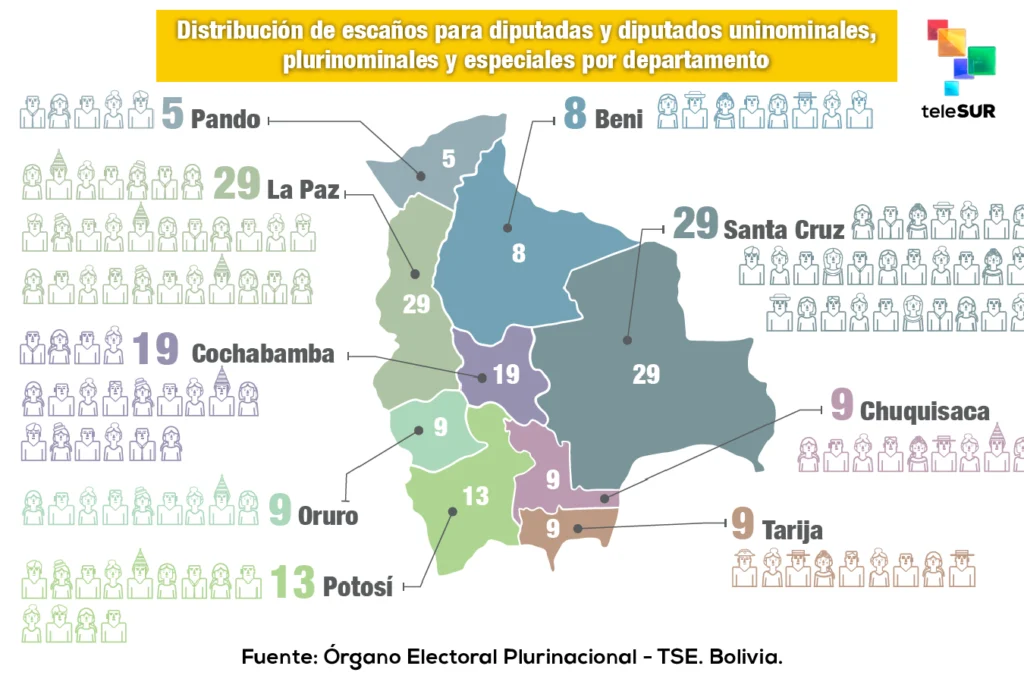
An Aymara woman attends the closing of the campaign of the presidential candidate for the Popular Alliance party, Andrónico Rodríguez, August 13, 2025, in El Alto, Bolivia. Photo: EFE.

Orinoco Tribune – News and opinion pieces about Venezuela and beyond
From Venezuela and made by Venezuelan Chavistas

An Aymara woman attends the closing of the campaign of the presidential candidate for the Popular Alliance party, Andrónico Rodríguez, August 13, 2025, in El Alto, Bolivia. Photo: EFE.
Today Bolivia will experience a decisive election day. More than 7.9 million citizens—including 369,931 voters living abroad across 22 countries—are eligible to elect new legislative and presidential representatives in elections that could extend into a runoff on October 19 if no candidate achieves presidential majority, that is, if no one clears the threshold of 40% of the votes + 10% over the nearest rival.
The Superior Electoral Tribunal (TSE) has enabled 3,733 polling stations throughout the country.
A complex electoral mosaic
Voters will elect the president and vice president, 36 senators, 130 deputies, seven representatives of special constituencies, Indigenous, and peasant groups, and nine parliamentary representatives to supranational bodies. This institutional architecture reflects the complex structure of the Plurinational State of Bolivia.
Although the TSE initially approved nine presidential tickets, the race has narrowed to seven main forces with active candidacies:
• Autonomy for Bolivia (APB-Súmate), with Manfred Reyes Villa
• Freedom and Progress Alliance (ADN), with Jorge “Tuto” Quiroga
• Popular Alliance, with Andrónico Rodríguez
• Unity Alliance, with Samuel Doria Medina
• Christian Democratic Party (PDC), with Rodrigo Paz
• Movement Toward Socialism (MAS-IPSP), with Eduardo del Castillo
• People’s Force Alliance, with Jhonny Fernández

Samuel Doria Medina: a businessman for the presidency
The Alianza Unidad candidate represents a center-right political project. At 66, the La Paz businessman is running in his fourth presidential bid after participating in 2005, 2009, and 2014.
Listed by Bolivian Business as the country’s second most influential businessman—behind only Marcelo Claure—Doria Medina ranks among Bloomberg’s 500 most recognized businessmen in Latin America and the Caribbean. His career includes serving in the Ministry of Planning and founding the National Unity Party in 2003 after leaving the Revolutionary Left Movement (MIR).
Jorge “Tuto” Quiroga: face of the traditional right
The 65-year-old Cochabamba native embodies Bolivia’s traditional right-wing option. President during 2001-2002, Quiroga’s institutional career includes serving as vice president under Hugo Banzer (1997-2001) and as finance minister during Jaime Paz Zamora’s administration (1989-1993).
His ties to the US position him as the candidate of dominant transnational economic sectors, though he publicly insists on maintaining an independent stance toward Washington. During dictator Jeanine Áñez’s interim government, he briefly served as Bolivia’s international spokesperson.

Andrónico Rodríguez: the new generation
The senator represents generational renewal within the union movement. At 36, Rodríguez built grassroots leadership among coca growers, rising through youth organizations to become executive secretary of the Mamoré Bulo Bulo Federation.
His academic background—political science, a master’s degree in security, defense and development, and various diplomas—complements his political experience. As Senate president, he was reappointed five times with broad support, consolidating his institutional profile.
Manfred Reyes Villa: a former military turned politician
The Cochabamba mayor’s career is marked by legal controversies. A former military officer and businessman, Reyes Villa governed Cochabamba from 1993 to 2000, served as departmental prefect until 2008, and previously ran for president in 2002 and 2009.
His record includes self-exile in the US from 2009 to 2019 after facing multiple lawsuits. His return during Áñez’s interim government enabled him to regain the Cochabamba mayoralty, though in 2022 he was sentenced to prison for an expropriation that occurred over 25 years ago.
Eduardo del Castillo: the continuity of MAS
The ruling party’s candidate faces the most complex challenge. The 36-year-old Santa Cruz lawyer was appointed as the minister of Government in 2020 and remained in his post until May 2025, becoming one of the most visible figures in Luis Arce’s cabinet.
A MAS party member since 2005, del Castillo built his career in public service and parliamentary advisory work, specializing in justice and migration issues. His candidacy represents the ruling party’s attempt to renew leadership amid internal divisions.

Evo Morales shadow and the null vote
The electoral campaign unfolds under tension. Former President Evo Morales, unable to register as a candidate with any legally established party, is actively promoting the null vote as political protest from his Cochabamba Tropics stronghold. This strategy responds to MAS’s internal tensions and rejection of both the Luis Arce administration and opposition candidates.
At his Entre Ríos campaign closure, Morales radicalized his discourse: “When the state does not respect the people’s rights, uprising and rebellion are a right. This will be a democratic rebellion against a corrupt state, a corrupt government and the entire right-wing party on the candidate list.”
Sunday’s results will determine whether Bolivia builds minimum consensus to address structural challenges, or whether its governability crisis deepens. It will serve as a referendum on the national model Bolivians want for the coming decades.
Division within the left and right
Bolivia’s left faces a deep schism as former President Evo Morales is actively promoting the null vote to undermine President Luis Arce’s chosen successor, Eduardo del Castillo. This fracture has split the ruling coalition and could erase MAS from official registration. Meanwhile, the right remains fragmented among rival candidates who are competing for the anti-MAS vote despite sharing pro-market platforms, diluting their collective strength against a weakened but still resonant left.
Bolivia Election Poll Shows Difficult Path for Left as Fragmentation Grows
Key economic challenges
• Inflation & shortages: Annual inflation hit 24.8%—a 40-year high—driving up costs of basics like food and fuel. Chronic fuel shortages force drivers to wait 4-24 hours for gasoline.
• Currency collapse: The boliviano’s official rate (6.96/USD) masks a black market rate of 14-15/USD, crippling imports and creating a dollar shortage.
• Subsidy burden: The state spent $2 billion in 2024 on fuel subsidies, unsustainable amid plummeting natural gas exports (down 50% since 2014).
Table: Economic indicators driving voter discontent
| Indicator | Status | Impact on Population |
|---|---|---|
| Inflation | 24.8% (June 2025) | Food prices doubled/tripled |
| Fuel Subsidies | $2 billion/year | Long queues, rationing |
| Dollar Reserves | Critically low | Credit card limits: $35/month |
| Natural Gas Exports | 50% decline since 2014 | Lost state revenue, job losses |
(Telesur) by Ricardo Pose with Orinoco Tribune content
Translation: Orinoco Tribune
OT/JRE/SC
Support Groundbreaking Anti-Imperialist Journalism: Stand with Orinoco Tribune!
For 7 years, we’ve delivered unwavering truth from the Global South frontline – no corporate filters, no hidden agenda.
Last year’s impact:
• More than 200K active users demanding bold perspectives
• 216 original pieces published in 2025 alone
Fuel our truth-telling: Every contribution strengthens independent media that actually challenges imperialism.
Be the difference: DONATE now to keep radical journalism alive!